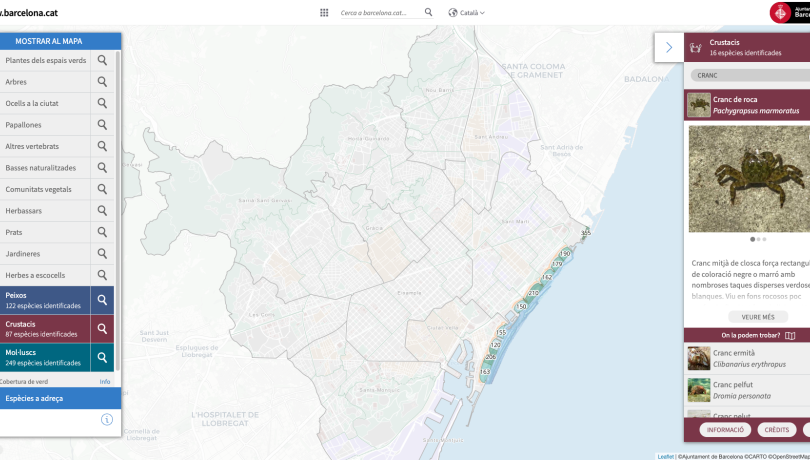The two new layers have been created entirely with citizen data collected by the ICM-CSIC, which in 2021 also allowed the fish layer to be added to the guide.

The Barcelona City Council has incorporated six new layers into the Barcelona Biodiversity Atlas, a digital tool open to the public that offers detailed information about the city's flora and fauna. This new version includes more than 450 new species distributed among the new layers of spontaneous herbs in tree pits, meadows, herbaceous plants, planter plants, crustaceans, and mollusks. With this update, the Atlas consists of 14 layers of different fauna and flora groups.
The crustacean layer, with 87 species, and the mollusk layer, with 249, along with the fish layer, are the only ones created entirely with data acquired by citizens using the citizen science platform MINKA, a digital interface where citizens can register species of flora and fauna collaboratively. These data, collected along the Barcelona coast from 2009 to 2023, have been reviewed and validated by the EMBIMOS research team of the ICM-CSIC. The data was provided to the Biodiversity Program of the Barcelona City Council along with the species profiles, including photographs taken by volunteers and descriptions of each species.
The updated version of the Atlas also includes new species in existing categories, such as the fish layer, created in 2021 with MINKA data, which has increased from 103 to 122 species. ICM-CSIC researcher Jaume Piera highlighted that
“The three unique marine biodiversity layers of the Atlas are completely made with data provided by citizens, which underscores the value of citizen science in understanding the natural wealth of our city and, in particular, the beaches of Barcelona.”
A New Vision of Marine Biodiversity in Barcelona
The publication of the new categories of crustaceans and mollusks highlights that the Barcelona coastline contains a great biodiversity richness, despite the high anthropogenic pressure. The data show that marine biodiversity exceeds terrestrial biodiversity in Barcelona, thus changing the social perception of the natural life of the city’s beaches.
“The beaches of Barcelona, previously seen as areas of sand and concrete, now reveal themselves as very rich ecosystems in biodiversity,” Piera emphasized.
A Collaborative Project, Within Reach of Barcelona's Residents
The Biodiversity Atlas, created by the Barcelona Municipal Institute of Parks and Gardens in 2019, is an online map that broadly represents the city's fauna and flora species. It is also an educational tool aimed at the academic community, open and downloadable, to make knowledge and the value of urban nature accessible.
The contents can be viewed in the 73 neighborhoods of the city or at a specific address, and each species has a brief description with the scientific and common name, accompanied by a photograph or illustration. The Atlas was created thanks to the work and collaboration of various scientific institutions, entities, organizations, and numerous people participating in citizen science projects.
A large part of the collection of marine fauna observations for the Atlas layers was made through citizen science initiatives where citizens participated in snorkeling and diving trips to collect observations in MINKA, such as BioMARató, with the funding of the European projects MINKE, ANERIS, GUARDEN and ECS, outings by the Catalan Federation of Underwater Activities (FECDAS) within the framework of the European project ANERIS, and the UrbamarBio project, co-led by ICM-CSIC and Anèl·lides - Marine Environmental Services.